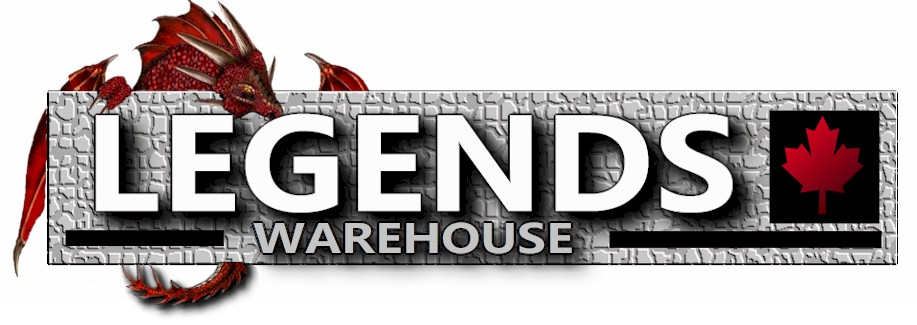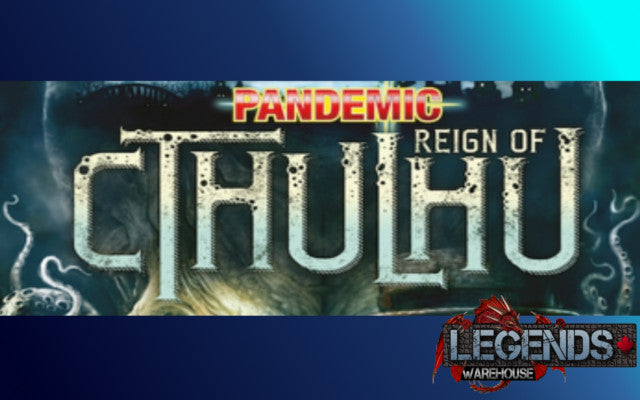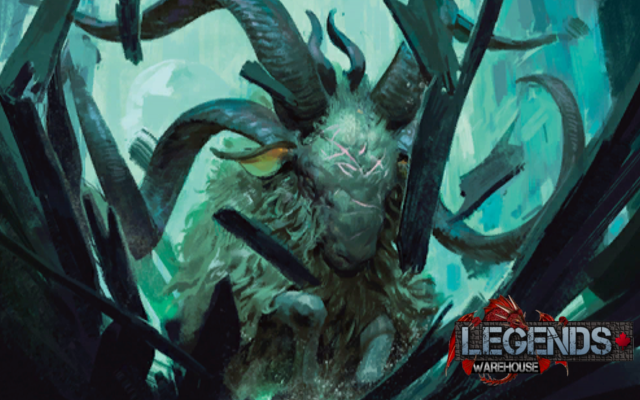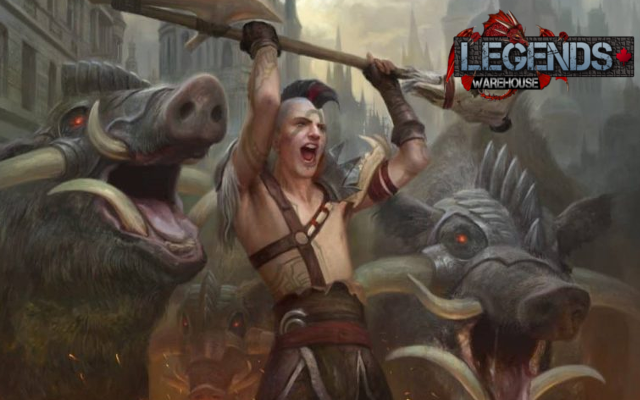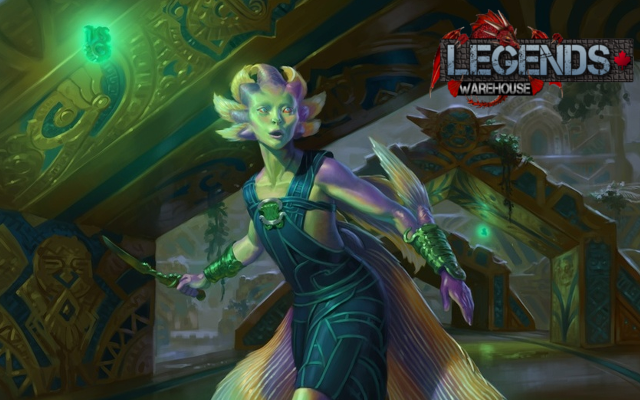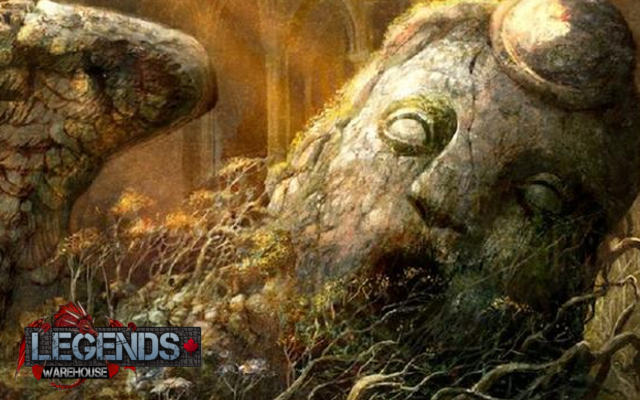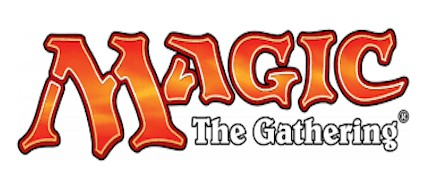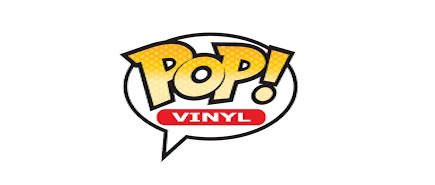Insanity Epidemics: An Intro to Pandemic: Reign of Cthulhu
- Legends Warehouse News
- 23 Jan, 2018
Pandemic is often touted as one of the best board game series of all time, and with good reason. As one of the earlier cooperative board games, Pandemic gave players the opportunity to work together to defeat the game itself rather than defeating each other. The increasing scale of difficulty and the various methods of losing the game offer a steadily rising challenge to keep players on their toes as they try to reach their goal of eradicating each of the four viruses. Over the years several expansions and variations have been printed, each with their own twists and turns. From the dice-based Pandemic: The Cure to Pandemic: Legacy where your progress and storyline carry over from one season to the next, there’s a version for everyone. For me, the version is Pandemic: Reign of Cthulhu.
I’m a sucker for anything eldritch horror. The concept of cosmic beings of unimaginable terror and madness is a great storytelling element, and having played more than my fair share of Arkham Horror, I was curious as to how the Cthulhu-themed version of Pandemic held up to its predecessor. While several elements from the original Pandemic appear, they are reskinned and twisted to suit the cosmic horror theme. For example, rather than fighting various virus outbreaks across the globe, players fight cultists trying to awaken the Great Old Ones and bring them to our world. Rather than the rate of contagion increasing like in the base version, each stage of the game comes with awakening a different old god until Cthulhu finally awakens and the game ends.
However, Reign of Cthulhu offers several spins to give the game its own unique feel. The biggest change is the introduction of sanity as a resource you have to manage. Sanity is important in this game since it has influence on so many of your interactions. Each player starts off with sanity tokens that they can lose over the course of the game, and are required to do “sanity checks” by rolling the sanity die in order to do certain actions like using Relic cards. When a player runs out of sanity tokens their character becomes insane and their role card is flipped over to their de-powered insane side. This offers players a whole other angle of being attacked, which makes the game even more of a challenge to overcome. After all, it’s one thing to fight off cultists, but can you truly defeat what’s lurking in your own mind?

Speaking of sanity, one of the other drains on your sanity are Shoggoths. These servants of the Great Old Ones act like the outbreaks in the base game, requiring several actions to clear up as opposed to just one like the cultists, but they do so much more. Unlike outbreaks, Shoggoths actually move around the board until they reach the nearest gate. It’s up to you to stop them because if they reach their goal, they summon an old god and accelerate the end of the game. Furthermore, should a Shoggoth land on a space occupied by a player or vice versa, that player does a sanity check, making them even more daunting a foe to fight.
Finally, the most important change to the game is that rather than simply ramping up the rate at which the cultists spread when an old god is revealed, each old god has abilities that either trigger when revealed or stay constant that hinder the player’s success. The game comes with twelve Great Old One cards, and Cthulhu is placed face down to the far right signifying the end of the game. The rest, however, are shuffled up and six are placed face down to Cthulhu’s left to be revealed at each awakening. This means that you have no idea which of the Great Old Ones are getting ready to ruin your day, so the effects they trigger can either be a mild pain in the neck to absolutely devastating.
rate at which the cultists spread when an old god is revealed, each old god has abilities that either trigger when revealed or stay constant that hinder the player’s success. The game comes with twelve Great Old One cards, and Cthulhu is placed face down to the far right signifying the end of the game. The rest, however, are shuffled up and six are placed face down to Cthulhu’s left to be revealed at each awakening. This means that you have no idea which of the Great Old Ones are getting ready to ruin your day, so the effects they trigger can either be a mild pain in the neck to absolutely devastating.
In my second playthrough we had, in succession, revealed Shub-Niggurath, Dagon, and Azathoth. This caused us to draw four Summoning cards and place cultists on those locations, put a cultist on each gate location, and remove three cultists from the unused supply, effectively using up eleven cultists! Since running out of cultists was a condition for losing, this shortened how much time we had to work with significantly and forced us to dramatically alter the way we were going to play. In a different game we had to deal with Hastur, who summoned an extra Shoggoth and moved them all one space closer to the nearest gates and then two turns later Shudde M’ell arrived and forced us to collectively give up five sanity tokens, making it even harder to fight off the Shoggoths. Giving the Great Old Ones abilities gives a depth of play that makes you have to roll with the punches and adapt as the game progresses.
After several games, I’ve found that like previous Pandemic titles, the most important factors to success in Reign of Cthulhu is movement. Movement is integral to the game since, unlike the base version, the gates are always in set locations, so it’s necessary to always have someone on your team that can take advantage of movement abilities. The Reporter, for example, can move from bus station to bus station without having to spend a card to travel, which makes it much easier to close gates, whereas the Driver may move two spaces per action rather than just one, which makes it much easier to reach certain locations. It’s also important to factor in traveling by gate to get from one area on the map to another. This gives powerful characters like the Hunter the ability to get to gates before they get too infested with cultists and Shoggoths. Just remember that once you’ve sealed a gate, you can’t use it to travel, so you have to plan ahead of time when you want to seal one off.

Overall I’ve found that I’ve enjoyed this version of Pandemic far more than the base version, and not just because of my own enjoyment of H.P. Lovecraft. The addition of the Great Old Ones gives the game an element of randomness that the base doesn’t have, and that randomness forces you to adapt or die. The sanity mechanic also give you resources to manage, and the Shoggoth actually moving around the board make cleaning up their mess quite the challenge. There’s a level of tension in this game that you just can’t get with basic Pandemic. You could find yourself clawing your way to a victory when a Shoggoth spawns too close to a gate and brings about the end of days. If you’re a die hard fan of Pandemic or Cthulhu, pick up Pandemic: Reign of Cthulhu and stop the apocalypse!
Pick up your copy today!